Great Ocean Road
The Great Ocean Road is an Australian National Heritage listed 243-kilometre (151 mi) stretch of road along the south-eastern coast of Australia between the Victorian cities of Torquay and Allansford. Built by returned soldiers between 1919 and 1932 and dedicated to soldiers killed during World War I, the road is the world's largest war memorial. Winding through varying terrain along the coast and providing access to several prominent landmarks, including the Twelve Apostles limestone stack formations, the road is an important tourist attraction in the region.
Great Ocean Road Surf Coast Highway | |
|---|---|
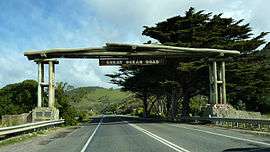 | |
Great Ocean Road memorial arch at Eastern View | |
 | |
| General information | |
| Type | Highway |
| Length | 243 km (151 mi) |
| Opened | 1932 |
| Route number(s) | |
| Former route number | |
| Major junctions | |
| East end | Torquay, Victoria |
| West end | Allansford, Victoria |
| Location(s) | |
| Major settlements | Anglesea, Aireys Inlet, Lorne, Wye River, Kennett River, Apollo Bay, Lavers Hill, Port Campbell, Peterborough |
| Highway system | |
The Great Ocean Road starts at Torquay and travels 243 kilometres westward to finish at Allansford near Warrnambool,[1] the largest city along the road.[2] The road is two lanes (one in each direction), and is covered by a speed limit changing between 50 kilometres per hour and 100 kilometres per hour.
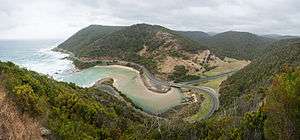
The road is considered a tourist attraction in the area,[3] in which much of the road hugs coastline affectionately known as the Surf Coast,[4] between Torquay and Cape Otway, and the Shipwreck Coast further west of Cape Otway, providing visibility of Bass Strait and the Southern Ocean. The road traverses rainforests, as well as beaches and cliffs composed of limestone and sandstone, which is susceptible to erosion.[5][6] The road travels via Anglesea, Lorne, Apollo Bay, and Port Campbell, the latter being notable for its natural limestone and sandstone rock formations including Loch Ard Gorge, The Grotto, London Arch (formerly London Bridge) and The Twelve Apostles.[7] At the stretch of the Great Ocean Road nearer to Geelong, the road meanders along the coast, with tall, almost-vertical cliffs on the other side of it. Road signs put up along the road warn motorists of possible rockfalls, which have occurred before.



The city of Geelong, close to Torquay, experiences great benefit from Australian and international visitors to the road; with Geelong Otway Tourism affirming it as an invaluable asset.[8][9] The Royal Automobile Club of Victoria (RACV) listed the road as the state's top tourism experience in its Victoria 101 survey, based on spots recommended by members and the public on what they would recommend to visitors.[10]
Events
Great Ocean Road Marathon
A 45 kilometre section of the Great Ocean Road, between Lorne and Apollo Bay, is the location of the annual "Great Ocean Road Marathon". First run in 2005, the marathon is part of the Great Ocean Road Running Festival.[11] The course record of 2:27:37 was set in 2019 by English runner Nick Earl.[12][13] Earl broke the previous record of 2:27:42 set in 2011 by James Kipkelwon of Kenya, who also won the event in 2012.[14]
Cycling Events
In July 2014, former World Road Cycling Champion and Tour de France winner Cadel Evans announced that the Great Ocean Road would play host to the Cadel Evans Great Ocean Road Race in early 2015, including elite races for men and women and a mass participation People's Ride.[15] As of 2019, the People's Ride includes three distance options—35 km, 65 km, or 115 km.[16][17]
Wiggle Amy's Gran Fondo cycling event is held in September and uses the section between Lorne and Skenes Creek.[18] One of the only cycling events in Australia held on a fully closed road, it is named for Amy Gillett, who was killed in a collision between the Australian women's cycling squad and a driver in Germany in 2005.[19]
History
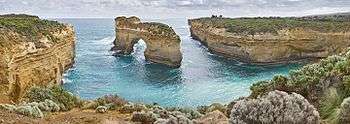
The Great Ocean Road was first planned towards the end of World War I, when chairman of the Country Roads Board, William Calder, asked the State War Council for funds to be provided for returned soldiers to work on roads in sparsely populated areas in the Western District.[20] At the time, the rugged south-west coast of Victoria was accessible only by sea or rough bush track.[21] It was envisaged that the road would connect isolated settlements on the coast, and become a vital transport link for the timber industry and tourism.[22]
Surveying for the road, tentatively titled the South Coast Road, started in 1918—with the road suggested to travel from Barwon Heads, follow the coast west around Cape Otway, and end near Warrnambool. In 1918, the Great Ocean Road Trust was formed as a private company, under the helm of president Howard Hitchcock. The company managed to secure £81,000 in capital from private subscription and borrowing, with Hitchcock himself contributing £3000. Money would be repaid by charging drivers a toll until the debt was cleared, and the road would then be gifted to the state.[23][24]
Construction effort

Construction on the road began on 19 September 1919. It was built by approximately 3,000 returned servicemen as a war memorial for fellow servicemen who had been killed in World War I. An advance survey team progressed through dense wilderness at approximately 3 kilometres a month. Construction was done by hand; using explosives, pick and shovel, wheelbarrows, and some small machinery,[6][22] and was at times perilous, with several workers killed on the job; the final sections along steep coastal mountains being the most difficult to work on. Anecdotal evidence from ABC archives in 1982 suggested workers would rest detonators on their knees during travel, as it was the softest ride for them.[22]
The soldiers were paid 10 shillings and sixpence for eight hours per day, also working a half-day on Saturdays. They used tents for accommodation throughout, and made use of a communal dining marquee and kitchen; food cost up to 10 shillings a week. Despite the difficulty involved in constructing the road, the workers had access to a piano, gramophone, games, newspapers and magazines at the camps.
In 1924, the steamboat Casino became stranded near Cape Patton after hitting a reef at Point Hawdon, near Grey River. A legend has grown around its cargo—claiming that it jettisoned 500 barrels of beer and 120 cases of spirits, and the road workers obtained the cargo, resulting in an unscheduled two-week-long drinking break—but Museums Victoria notes only that most of the cargo, largely composed of Christmas goods, was dumped into the sea.[25]The Age reported that, "The Great Ocean-road [sic] proved a boon to the passengers, who were enabled without much inconvenience to reach Wood's farm house, Apollo Bay. However, if the road were finished, the vessel's cargo could be safely conveyed to either Apollo Bay, the Wye River, or Lorne."[26]
Completion and early usage
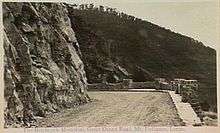
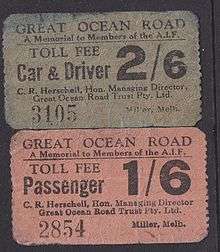
On 18 March 1922 the section from Eastern View to Lorne was officially opened with celebrations. However it was then closed from 10 May 1922 for further work; opening again on 21 December along with tolls to recoup construction costs. The charge, payable at Eastern View, was two shillings for motor cars, and 10 shillings for wagons with more than two horses.[1]
In November 1932, the section from Lorne to Apollo Bay was finished, bringing the road to completion. The road was officially opened with Victoria's Lieutenant-Governor Sir William Irvine holding a ceremony near Lorne's Grand Pacific Hotel, and the road subsequently being acknowledged as the world's largest war memorial.[9] At the time, The Age commented, "In the face of almost insurmountable odds, the Great Ocean Road has materialised from a dream or 'wild-cat scheme', as many dubbed it, into concrete reality".[1] Although Hitchcock had died of heart disease on 22 August 1932, before the road was completed, his car was driven behind the governor's in the procession along the road during the opening ceremony.[23] A memorial was constructed in his name on the road at Mount Defiance, near Lorne, and he is still affectionately considered the Father of the Road.[27]
Rood, David (10 April 2007). "Road's still great, 75 years on". The Age. Retrieved 26 June 2010.
In its original state, the road was considered a formidable drive, fitting only a single vehicle comfortably at a time. Areas with sheer cliffs would be most hazardous, with only few places for drivers to pull over to allow others to proceed in the opposite direction; for £5, any "public-spirited citizen" could request that a crossover be cut into the road.[21][28] On 2 October 1936, the road was handed to the State Government; with the deed for the road presented to the Victorian Premier at a ceremony at the Cathedral Rock toll gate. It was at this time that the tolls were also removed.[1]
In 1939 with the death of the chairman of the Country Roads Board WTB McCormick, who was also honorary engineer for the Great Ocean Road Trust, it was decided to build a memorial arch across the road at Eastern View.[29] The arch was built of timber logs on a stone base, with a tablet memorial to Mr McCormick on one side, and another to the returned servicemen on the other, was opened 4 November 1939.[30] The arch was rebuilt in 1973, and again in 1983 when it was destroyed by the Ash Wednesday bushfires.[31]
In 1962, the road was deemed by the Tourist Development Authority to be one of the world's great scenic roads.[32] It also had sections widened between the Lorne Hotel and the Pacific Hotel to improve traffic, while aiming to preserve its character.[33] Despite improvements, the road was still considered a challenging drive; the Victorian Police motor school even used it for training around 1966.[34]
Over its life, the Great Ocean Road has been susceptible to natural elements; in 1960 the section at Princetown was partially washed away by water during storms.[35] It experienced landslides on 11 August 1964,[36] and in 1971; both closing sections of the road near Lorne.[37] Because of the terrain surrounding the road, it was also closed due to bushfires in 1962[38] and 1964; particularly in areas with nearby campsites.[39] In January 2011 a section of the overhanging cliffs collapsed due to heavy rain.
In 2011, the road was added to the Australian National Heritage List.[40]
Great Ocean Walk
In 2004, the Great Ocean Walk opened, connecting 104 km of walking trails that follow the coastline near the Great Ocean Road, stretching from Apollo Bay to the 12 Apostles.[41][42][43]
Engineering heritage award
The road received an Engineering Heritage National Marker from Engineers Australia as part of its Engineering Heritage Recognition Program.[44]
See also
References
- Rood, David (10 April 2007). "Road's still great, 75 years on". The Age. Retrieved 26 June 2010.
- "Doncaster site to house shops, offices and flats". The Sydney Morning Herald. 12 June 2010. Retrieved 24 June 2010.
- Waters, Kim (20 May 2010). "Critics slam policy to ban coast wind farms". Geelong Indy. Star News Group. Retrieved 14 May 2019.
- "Surf Coast Towns & Villages - Visit Great Ocean Road". www.visitgreatoceanroad.org.au. Retrieved 14 May 2019.
- Campbell, David (2 January 2006). "Preserving the fragile Great Ocean Road". The Age. Retrieved 25 June 2010.
- Goggin, Eleanor (30 May 2010). "Surfing the vineyards on the Ocean Road". Sunday Independent. Independent.ie. Retrieved 8 June 2010.
- "The Lonely Planet online guide to the road". Retrieved 19 May 2008.
- Harper, Jane (17 July 2008). "Geelong has a billion reason to thank tourists". The Geelong Advertiser. Retrieved 9 June 2010.
- Grant, Roger (9 June 2010). "Extra Tiger flights make Geelong a must-see". www.geelongadvertiser.com.au. The Geelong Advertiser. Retrieved 9 June 2010.
- "Great Ocean Road 'top tourism experience'". couriermail.com.au. Queensland Newspapers. 29 September 2008. Retrieved 25 June 2010.
- "Great Ocean Road Running Festival - Australia's Most Stunning Marathon". Great Ocean Road Running Festival. Retrieved 14 May 2019.
- "Community Sports: Melbourne high for local runner | The Star Online". www.thestar.com.my. Retrieved 21 June 2019.
- "2019 Marathon Results: Great Ocean Road Run Festival". tomatotiming.racetecresults.com. 18 May 2019. Retrieved 21 June 2019.
- Sum, Eliza (22 May 2012). "Highton man second in marathon". Archived from the original on 2 November 2012. Retrieved 22 May 2012.
- "Cadel Evans Great Ocean Road Race announced". sbs.com.au. 17 July 2014. Archived from the original on 19 December 2014. Retrieved 18 December 2014.
- "Overview". Cadel Evans Great Ocean Road Race. Retrieved 14 May 2019.
- "What To Expect at the Cadel Evans Great Ocean Road Race People's Ride". www.bikeexchange.com.au. Retrieved 14 May 2019.
- "Amy's Gran Fondo – Wiggle Amy's Gran Fondo 2019". Retrieved 14 May 2019.
- "Riding Amy's Gran Fondo - Great Ocean Road, Australia | Bike Tour Buzz". biketourbuzz.com. Archived from the original on 27 February 2017. Retrieved 14 May 2019.
- Southern, Roger J. "Calder, William (1860–1928)". adbonline.anu.edu.au. Australian National University. ISSN 1833-7538. Retrieved 24 June 2010.
- Downes, Stephen (26 November 1982). "Great Ocean Road turns 50". The Age. p. 11. Retrieved 29 July 2019.
- "Moment in Time – Episode 27". Australian Broadcasting Corporation. Archived from the original on 4 February 2011. Retrieved 26 June 2010.
- Wynd, Ian. "Hitchcock, Howard (1866–1932)". www.adb.online.anu.edu.au. Australian National University. Retrieved 24 June 2010.
- "The Great Ocean Road". The Sydney Mail. 24 April 1935. Retrieved 25 June 2010.
- "Photograph - Victorian Collections". victoriancollections.net.au. Retrieved 14 May 2019.
- "S. Casino Still Aground: Position Precarious". Newspapers.com. The Age. 23 October 1924. Retrieved 14 May 2019.

- Davis, Michael (14 April 2007). "Hard road to honouring Diggers". The Australian. Archived from the original on 1 May 2015. Retrieved 26 June 2010.
- "Double Lines Needed On Ocean Road". Newspapers.com. The Age. 10 June 1961. Retrieved 21 June 2019.

- "Memorial Arch At Eastern View". Age (Melbourne, Vic. : 1854 - 1954). 6 June 1939. p. 14. Retrieved 3 May 2020.
- "OCEAN ROAD PIONEER". Age (Melbourne, Vic. : 1854 - 1954). 4 November 1939. p. 36. Retrieved 3 May 2020.
- "Great Ocean Road Memorial Arch | Monument Australia". monumentaustralia.org.au. Retrieved 3 May 2020.
- "Great Ocean Road in World Class". The Age. 15 August 1962. p. 4. Retrieved 25 June 2010.
- "Widening of Lorne Road". Newspapers.com. The Age. 8 September 1962. Retrieved 21 June 2019.

- "Tighter averages on poor roads in tough run". The Sydney Morning Herald. 4 December 1966. Retrieved 29 June 2010.
- "Washaways". The Age. 23 April 1960. Retrieved 29 June 2010.
- "Landslide Closes Great Ocean Road". The Age. 12 August 1964. Retrieved 25 June 2010.
- "Ocean Road open – but watch out". The Age. 9 December 1971. Retrieved 29 June 2010.
- "Fire Survey Finds Another 200 Homes were Lost". Newspapers.com. The Age. 20 January 1962. Retrieved 21 June 2019.

- "Great Ocean Road Closed". The Age. 8 January 1964. Retrieved 29 June 2010.
- Johnston, Matt (7 April 2011). "Great Ocean Road added to Australia's national heritage lis". HeraldSun. Retrieved 7 April 2011.
- "Great Ocean Walk". Visit Victoria. Tourism Victoria. Archived from the original on 27 December 2011. Retrieved 22 December 2011.
- "The Great Ocean Walk, Great Ocean Road and Region, Victoria, AustraliaGreat Ocean Walk". www.greatoceanwalk.com.au. Retrieved 6 August 2019.
- Victoria, Parks (8 August 2019). "Great Ocean Walk". parkweb.vic.gov.au. Victorian Government, Parks Victoria. Archived from the original on 6 June 2019. Retrieved 6 August 2019.
- "Great Ocean Road, 1932-". Engineers Australia. Retrieved 28 April 2020.
External links
| Wikimedia Commons has media related to Great Ocean Road. |
| Wikivoyage has a travel guide for Great Ocean Road. |
- Great Ocean Road – Official state government tourism site Retrieved 21 August 2017.
- Great Ocean Road Great Ocean Road Regional Tourism Ltd. Retrieved 10 December 2018.
- Great Ocean Road Guide Local's Guide to Exploring the Great Ocean Road Beyond the Guidebook.
- Great Ocean Road Map An Interactive Map showcasing 150+ attractions, places of interest, campsites, waterfalls, petrol stations and more on and around the Great Ocean Road
- Local accommodation website for the Great Ocean Road Retrieved 21 August 2017.

![]()
- Great Ocean Road The Complete Guide